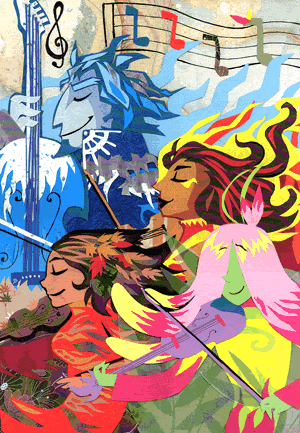 Antonio Lucio Vivaldi (Venice, March 4, 1678 – Vienna, July 28, 1741) was a composer and a late Baroque musician, one of the pinnacles of the Baroque era in Western and universal music. His skills are reflected in his foundational contributions to the concerto, one of the most important musical forms of his time.
Antonio Lucio Vivaldi (Venice, March 4, 1678 – Vienna, July 28, 1741) was a composer and a late Baroque musician, one of the pinnacles of the Baroque era in Western and universal music. His skills are reflected in his foundational contributions to the concerto, one of the most important musical forms of his time.
Vivaldi was nicknamed il prete rosso (“the red-haired priest”) because he was a Catholic priest with red hair. He composed a total of 770 works, including 477 concertos and 46 operas.
Vivaldi had a deep love for life, and to capture the profound emotions awakened by nature’s transformations, he created the violin concertos known as “The Four Seasons.” In the original scores, he provided descriptions of the most beautiful scenes of spring, summer, autumn, and winter. Each of these concertos consists of three movements: two fast ones contrasting with a slow and expressive one, with the most descriptive scenes in the movements.
The Four Seasons (Musical Work) Explained:
Spring
After a long winter that blankets the landscape in white, spring bursts forth in a colorful explosion. Flowers, butterflies, and the songs of birds herald this beautiful season with joyous hymns. Birds join in the general celebration with their trills and melodies (performed by three solo violins). In the distance, you can hear the gentle murmur of a babbling stream. Spring is also known for its sudden heavy downpours, announced by lightning and thunder.
The second movement depicts a scene where a young shepherd has fallen asleep. The gentle breeze produces a soothing murmur, and the solo violin describes the shepherd’s sweet and peaceful dream. In the third movement, a festive celebration unfolds with jubilant songs and dances, celebrating the arrival of spring.
Summer
Summer is the season of heat. Vivaldi tells us that the high temperatures affect both humans and animals, causing a sense of lethargy, which he musically describes. He also portrays the rhythmic song of the cuckoo on warm summer nights and the languid melody of a lark during summer sunsets.
In the second movement, a farmer returns home after a grueling day of work. Exhausted, he tries to sleep, but a thunderclap in the sky announces a storm that interrupts his dreams. This scene repeats several times and is connected to the third movement, which depicts the unleashed forces of nature in a fierce storm.
Autumn
Autumn is a joyous season as it signifies harvest time, and the act of sowing good seeds has resulted in a bountiful harvest, bringing great happiness. However, the joy is suddenly interrupted, and the music shifts to a more tranquil melody. In every celebration, there’s always someone who overindulges and seeks a peaceful nap.
In autumn, leaves gradually dry up and, propelled by the caress of the wind, fall to the ground, forming a crunchy carpet underfoot. The harpsichord plays a melody that evokes the whimsical fall of the dry leaves.
The third movement portrays the favorite pastime of Vivaldi’s time: hunting. A lively and playful melody represents hunters gathering at dawn with laughter and banter, preparing for a grand hunt. The solo violin, accompanied by the orchestra, mimics the sound of the hunting horn, creating a series of dialogues between the violinist and the orchestra, depicting the adventure of pursuing prey.
Winter
The opening notes depict the slow, persistent fall of snowflakes, and the rapid trills of the violins represent the chattering of teeth caused by intense cold. A gust of wind is heard, shaking the falling snowflakes in the first violin solo. The music gradually intensifies, leading to a grand theme.
The second movement, titled “Rain,” portrays a contented man, warm and snug by the fireplace while observing the winter raindrops striking his window. The rhythmic falling of raindrops is accompanied by a violin solo that sings a beautiful melody, conveying the happiness and warmth of home.
The third movement begins with a solo violin, followed by the orchestra, simulating a gentle gust of wind that gradually grows stronger. As it concludes, a fierce winter storm arrives, brought on by the Mediterranean winds, and the snowdrifts of the North are depicted by the violin solo and the orchestra, culminating in a beautiful ending.
“So it is with winter, but it also possesses great beauty,” Antonio Vivaldi concludes his magnificent work, the cycle of “The Four Seasons.”
Video: Vivaldi’s Four Seasons Musical Work
Notes:
- Direction and production: Audio by the String Section of the Coyoacán Symphony Orchestra, 2000.
Image by OwlGem via Flickr
Datos para citar este artículo:
Sección de cuerdas de la Orquesta Sinfonica de Coyoacán. (2010). Antonio Vivaldi and the “Four Seasons” explained. Revista Vinculando, 8(2). https://vinculando.org/en/antonio_vivaldi_the_four_seasons_explained.html
John Hazlett dice
Beautiful. Thank you.
Revista Vinculando dice
With pleasure John, the author meant to share this useful information for everyone to better appreciate this beautiful piece. Regards ;)
ben dice
you saved my life!
Revista Vinculando dice
We’re glad this article helped you Ben. Regards!
JESSICA dice
Great article. However I am wondering if you know where I can buy that painting/poster that you have above? Thank you so much.
Revista Vinculando dice
Hello Jessica,
We found the picture you refer to on the internet, so we cannot tell you if you can find posters of it. We wish you can find the high-res source to get a great looking image. Regards.